Is your content marketing dead in the water? Are your product descriptions a yawn and your emails lying unopened, while your competitors strut about with overflowing carts?
Forget ho-hum list posts and trite buzzwords. They’re peashooters in the war for attention.
What you need is the bazooka of persuasive copywriting.
It’s the weapon of mass engagement, crushing customer apathy and detonating a desire so powerful they won’t know what’s hit them.
It’s not about clever tricks or fancy phrases. It’s about crafting narratives that breach the walls of indecision and build bridges of trust and credibility.
Ready to fight for your brand? Then buckle up. It’s a battlefield out there.
What is Persuasive Copywriting?
Persuasive copywriting has one aim – to convince people to take a specific action, such as purchasing a product, subscribing to a service, or even adopting a certain viewpoint.
It uses compelling language that connects with customers’ basic human needs and emotions and persuades them you have the solution to their problem.
There are two important psychological elements to remember about persuasive copywriting:
- You have to know the needs, desires and pain points of your target audience to tailor your message effectively.
- While encouraging them to take action, you must remain ethical and honest. Trust and credibility are key.
Understanding the Importance of Copywriting Psychology
Harvard Business School professor Gerald Zaltman, says 95% of consumers’ decision-making process takes place in the subconscious mind, which is hard-wired to their deep-seated desires. This is where they intuitively decide if they like and trust your persuasive narrative enough to take action.
By the time the process reaches their conscious mind and logic kicks in, it’s too late. All their rational brain can do is justify their decision to buy.
Here’s an example of how this works. I like to call it ‘spot the difference’:
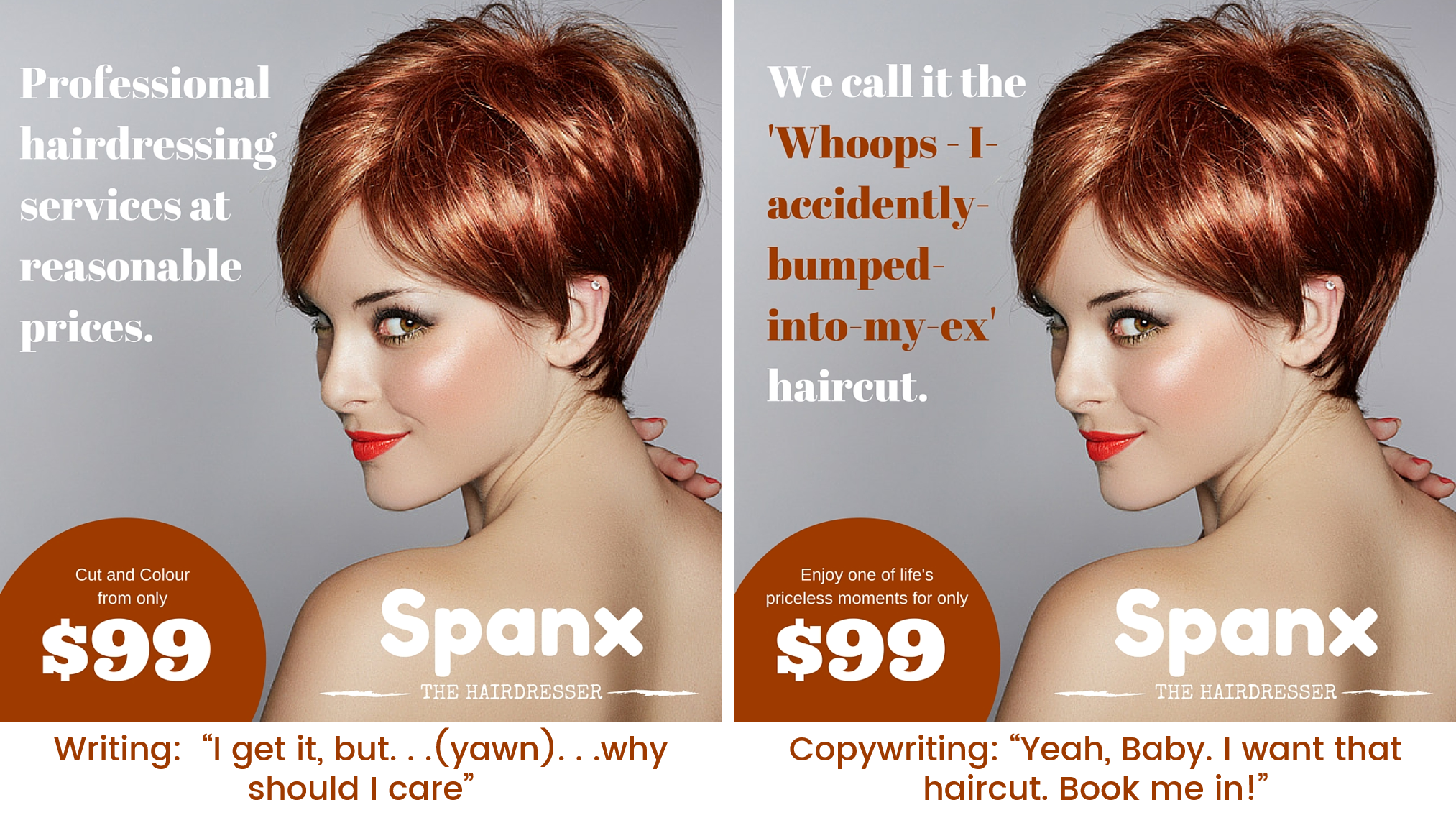
Which hairdresser instinctively appeals to you?
The one who talks about their service and pricing, or the one who taps into your innate desire for a head-turning haircut, with a little twist of humour?
The war for attention isn’t won by talking about features and pricing. You need to focus on the emotional, social and physical outcomes for your customers. It’s about triggering their imagination with sensory details and connecting with their defenceless subconscious.
Here’s how:
9 Essential Techniques of Persuasive Copywriting
1. Write Headlines That Spark Curiosity, Create Urgency or Offer Solutions
Most businesses these days use a combination of websites, blog posts, social media, and emails as content marketing tools. And in many cases, headlines are tossed in as an afterthought.
Big mistake.
If your headline doesn’t spark curiosity, evoke an emotion or offer a solution, no one’s going to click through. According to CoSchedule, 8 out of 10 people may scan a headline, but only 2 out of 10 will actually read on.
In their comprehensive guide to writing headlines, CoSchedule suggests you should be writing a bare minimum of 25 draft headlines before you settle on the right one, and that traffic could vary up to 500% depending on your headline.
Here are some examples using the techniques they suggest:
-
- The Unexpected Habit That Will Make You 10x More Productive (It’s Not What You Think).This one challenges expectations and offers a surprising solution. Using brackets is also an effective psychological trigger. According to a study by Hubspot, titles that contained brackets got 38% more clicks than titles without them.
- Turns Out Everything You Know About Sleep is Wrong. Here’s the Truth.This headline creates disbelief and promises unexpected knowledge. It also uses negative words like ‘wrong’, which have more impact than positive words.
- 10 Proven Techniques for Boosting Your Conversion Rate. Using numbers is more specific and compelling than just saying ‘Ways to boost your conversion rate’.
- Online Italian School is NOW OPEN just for you, Ann. This email subject line creates urgency, exclusivity and personalisation in just 10 words.
2. Build Trust and Credibility Through Social Proof
In the online world, where trust is scarce, ‘social proof’ is a key weapon.
It’s the psychological phenomenon where people assume something must be good if others are endorsing it – think packed restaurants buzzing with conversation, or product pages with overflowing review sections.
By harnessing this inherent human instinct, you can transform scepticism into trust, and clicks into conversions.
So, sprinkle your content with glowing customer testimonials, show off those five-star ratings and highlight impressive statistics about your business. But make sure they are all genuine.
Here’s a good example of a landing page for Fender guitar lessons, which proudly shows off its track record and the recognisable brands that endorse it.
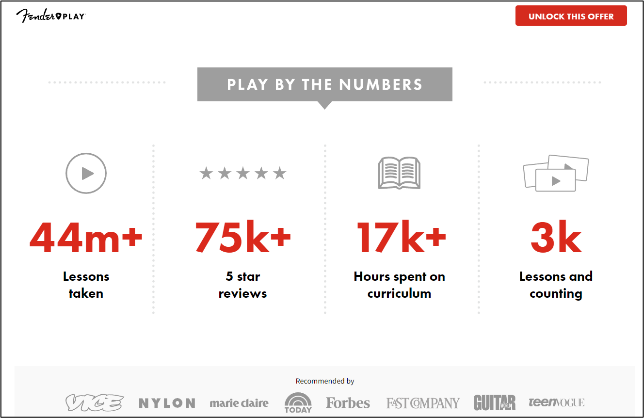
When potential customers see others singing your praises, it acts as a powerful validation, adding instant credibility to your brand and nudging them towards that coveted click or purchase.
3. Overcome Their Objections Before They Can Voice Them
The decision-making process is peppered with landmines of objections. Buyers always have questions about quality, delivery, and refund policies. One niggling doubt and they’ll hesitate, then click away.
Instead of waiting for objections to arise, be upfront about the ‘what ifs’ in your copy. Is your product a bit pricier than others? Explain the premium materials and craftsmanship that justify the cost. Are they worried about commitment? Offer a generous return policy or highlight flexible subscription options.
Ikea has a whopping 365 days return policy on most products, and a 90-day free trial on its mattresses.
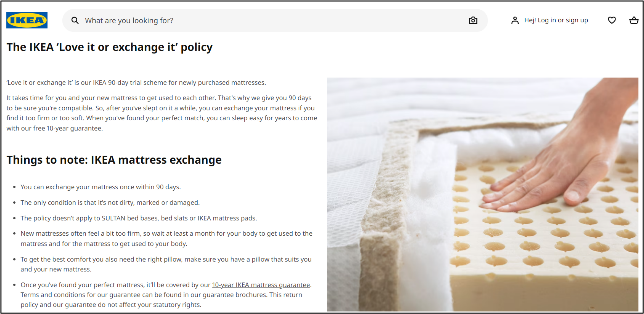
By pre-emptively addressing worries, you build trust and show you understand their concerns. McDonalds is a master at this, using its Q&A page to address every question that’s ever been raised. Go ahead and scroll through some of them. There are 973 in total.
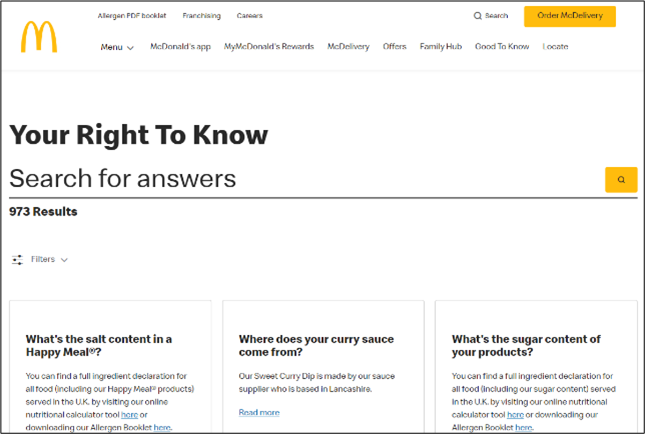
4. Avoid Jargon and Babble – Make Your Copy Sing
Avoid industry jargon and ‘flabby’ filler words at all costs. Your marketing isn’t a dusty textbook; it’s a conversation with real people.
Don’t say ‘let’s synergise our core competencies’. Say, ‘let’s combine our skills and work together.’
When it comes to persuasive copywriting, clarity reigns supreme.
Ditch the technical lingo and opt for language that sings, sparks, and sizzles. Like this product description from Method:
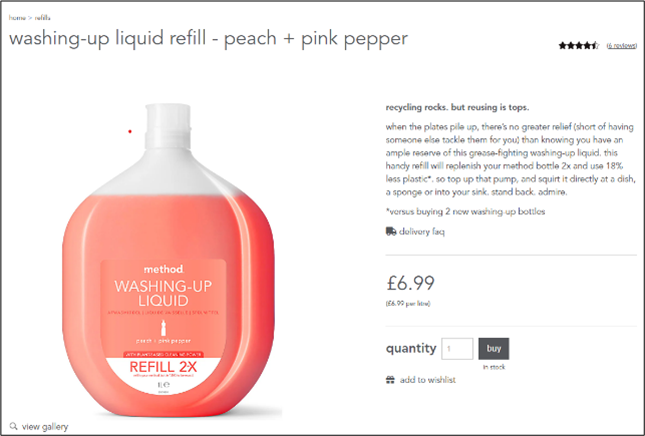
Scroll down to read about the fragrance: ‘On the surface all velvety peaches and sophisticated black currants. But watch out for that cheeky pink peppercorn edge. Seriously addictive’.
Who’d have thought you could make washing up liquid sound so enticing?
If you want to create sales copy as good as this, here’re a few tips:
- Speak your customers’ language, literally. Interview them. Ask them about their views on your product and service and then use their exact words in your copy.
- Write in the active voice – instead of saying ‘Your workload will be streamlined by our software’, say ‘Our software will simplify your work’.
- Use vivid verbs like stride, skip, amble, meander, wander, sidle, hike, saunter, stroll, instead of ‘walk’.
- Paint pictures with your words, tell stories that resonate and avoid the dreaded ‘corporate speak’ that sends readers fleeing for the hills. Here’s an extract from a product description about an artisan sourdough loaf: ‘This isn’t your average supermarket loaf. Look at that golden crust, smell the tangy aroma. And it toasts like a dream – a perfectly crisp golden shell giving way to that pillowy interior. Lather it in your favourite jam, dunk it in soup, or simply savour it with a bit of olive oil.’ Yum!
Simplicity and clarity isn’t dumbing down; it’s about crafting a message that cuts through the noise and lands directly in your audience’s hearts and minds.
Make it clear and relatable, a conversation they’ll crave, not a lecture they’ll snooze through. That’s where the power of persuasive copywriting truly wins out.
5. Create Emotional Connections Through Brand Storytelling
In a survey by Customer Thermometer, 65% of people connected with a brand because they said ‘the brand cares about people like me’. Another 55% felt the brand was ‘making a positive difference in the world’, and 45% expressed the connection as ‘they get me’.
So, how can you do this for your business?
Weave captivating stories into your content that paint vivid pictures in your reader’s mind and resonate with their beliefs and values. Share customer journeys, highlight real-life struggles overcome, and showcase the joy your product or service brings.
GoPro, for example, was founded by a photo and video enthusiast in search of a better way to film himself and his friends surfing. The brand has never lost sight of its purpose (‘We believe sharing and reliving our experiences makes life more meaningful and fun’). As a result, it has created a connected and passionate community whose members consistently share their GoPro stories.
Let your audience connect with each other and the people behind your brand, not just the features on your product page.
Humans are emotional creatures. It’s what makes us unique. We make decisions based on how something makes us feel, and whether we like and trust the brand.
Petalon is a UK florist, but flowers are not their first priority. The environment is. Petalon donates 100% of its profits to conservation projects, and it’s built a loyal following off the back of its visionary story:
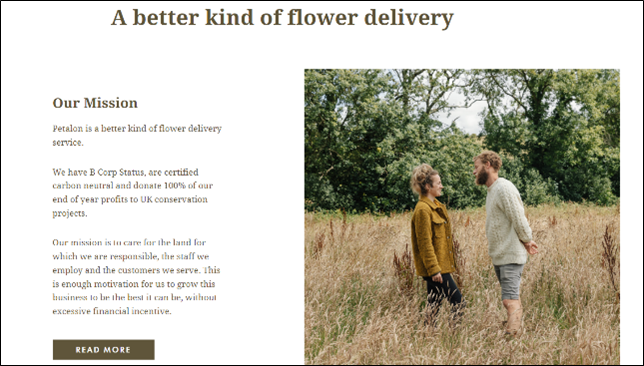
Tap into that innate desire for connection, for inspiration, for hope. Make your reader smile, shed a tear, or feel a warm flutter of excitement. When you move them emotionally, you move them towards action.
6. Sell Your Benefits, Not Your Features
Features are fancy specs on a page, but benefits are the tactical missiles of persuasive copywriting because they directly target your customers’ specific pain points.
The trick is to keep asking the ‘so what?’ question.
So what if your mattress has 6,000 springs? Who cares?
Instead, tell them it’s 3x more comfortable than other mattresses. It helps banish sleepless nights and improve health and well-being. Tell them about the anxieties your mattress will alleviate and the joys it will unlock. Now they care.
People don’t buy features, they buy the transformative experiences those features enable.
Craft your copy around the ‘why’ not the ‘what’. Speak to their deepest desires and their yearning for a better life.
Sofology, for example, focuses on its key purpose: ‘To help everyone feel at home on a sofa they love’, and their entire advertising campaign is based on how their sofas make you feel.
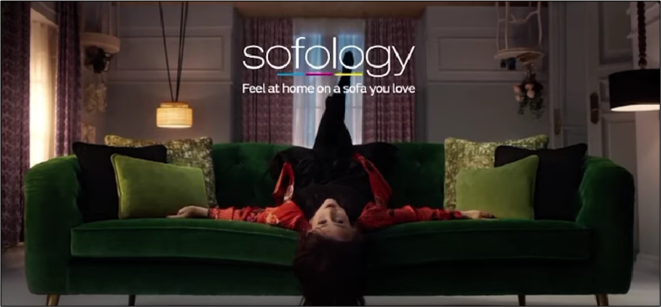
Their About Us page says: ‘We understand that a sofa is one of the biggest investments you will make . . . . This means finding a design that you will fall in love with every day when you flop, plonk or perch at home, and a style to snuggle up on that will stand the test of time.’
No mention of the frame construction or the firmness of the springs here. And who cares? We’re buying a place to snuggle, not a sofa.
7. Use the Rocket Power of Scarcity and Urgency
A friendly nudge can go a long way in persuasive copywriting. Send off a couple of warning shots about time running out or limited spaces, and you can turn indifferent website browsers into eager buyers.
Let your audience know, ‘this won’t last forever.’ Highlight dwindling stock, or showcase exclusive pre-launch opportunities.
Create a sense of FOMO (fear of missing out) – a gentle reminder that hesitation can mean losing out on something exclusive or desirable. Something that everyone else wants too, so it won’t last long.
Clothes retailer, Free People, has this tactic down pat with emails like this one:
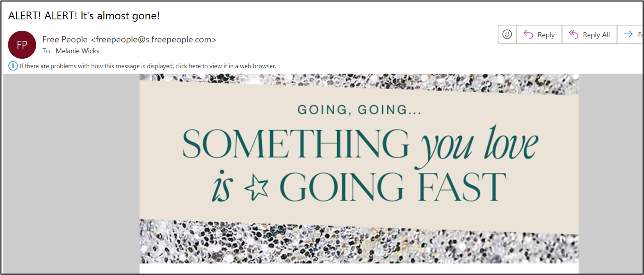
Think countdown timers ticking away, or urgent emails announcing ‘seats filling fast.’ Don’t be afraid to inject a touch of excitement, a shot of urgency that sparks that impulsive ‘buy now’ click.
Remember to use these tools ethically, but don’t underestimate the power of a well-placed ‘only ten spots left!’ or the reminder of a disappearing discount.
Let scarcity and urgency become your allies, gently persuading your audience to act before it’s too late.
8. Aim for Brand Consistency in Everything You Do
In the quest to win hearts and clicks, brand consistency is one of your mightiest weapons.
Every word, every phrase should be an extension of your core values, because persuasive copywriting isn’t about individual lines of text; it’s the clear, ongoing melody that weaves its way through your content, from blog posts to packaging.
Think of your ideal customer. Are they quirky and playful? Or sophisticated and refined? Let your language reflect your brand’s personality, using consistent vocabulary, humour styles, and sentence structures.
Avoid jarring shifts from technical jargon to casual slang. Don’t publish a blog post on a Monday if you’ve promised to do it every Friday.
Brand consistency builds trust and familiarity. Imagine your target audience being bombarded by a barrage of jarring competitors’ voices. Suddenly they hear the unwavering dependability and conviction of your message, standing head and shoulders above the noise of others.
Think of Apple. What comes to mind?
That simple yet evocative logo. The allure of their products as each one is unveiled from a shroud of secrecy. The global consistency of the brand voice, product design, packaging, pricing. . .everything.

9. Always Include a Call To Action
The final flourish, the last hurrah in your war for attention: the call to action (CTA).
Don’t let your audience get away as they finish reading and simply… shrug.
Lead them towards the door between information and decision with clear, compelling CTAs that are action-oriented, specific, and offer a sense of immediate gratification.
Don’t use generic terms like ‘click here’. Spur them into action with a more vivid picture of what awaits them. It might be ‘Unlock Your Dream Life Today’, or ‘Start Your Free Trial Now’, or ‘Join Our Exclusive Club’.
Don’t be afraid to inject a touch of urgency (‘Claim Your Discount Before It’s Gone!’) or tap into human desire (‘Live a Pain-Free Life Now!’). Make them feel the click is not just a click, but a leap towards their ideal self, a door flung open to possibilities.
Above all, don’t leave your audience at the edge of the cliff – offer them the rope, the ladder, the hand outstretched, ushering them towards that pivotal click and finally, conversion.
A Final Word on The Power of Persuasive Copywriting
In wrapping up, remember this: persuasive copywriting isn’t just a fancy skill—it’s your secret weapon to connect deeply with your audience and boost your online engagement.
By tapping into the psychology of persuasion and wielding techniques like curiosity-inducing headlines, social proof, and emotional connections, you’re not selling a product; you’re crafting an experience that resonates with your customers.
Whether you’re countering objections, celebrating the benefits over features, or building a sense of urgency, each tactical move is a step towards winning the war for attention, conversions and, ultimately, loyal customers.

